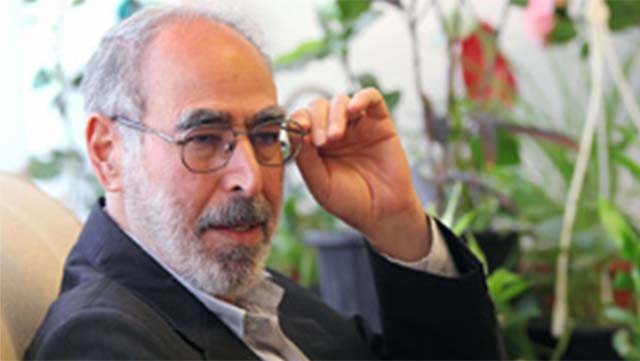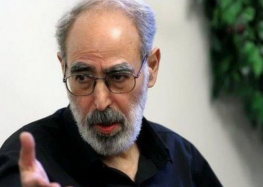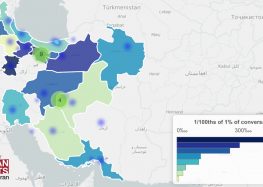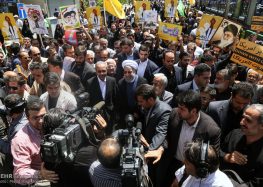Reformist Politician: President Rouhani Must Stand Up to Supreme Leader Khamenei’s Hardline Policies

Supreme Leader Ali Khamenei’s ongoing public criticism of President Hassan Rouhani is “rooted in the fact that the leader of the Islamic Republic of Iran does not recognize the people’s vote,” a reformist politician and former political prisoner told the Center for Human Rights in Iran (CHRI).
“However, the state’s elected portion, with its massive popularity, should resist attempts to block the implementation of the Constitution, and defend people’s rights,” said Abolfazl Ghadyani, a senior member of the reformist Mojahedin of the Islamic Revolution of Iran Organization (MIRIO) party, referring to the Rouhani government.
“The question is: How strong is Mr. Rouhani?” he added. “I don’t think he’s very strong, but during the election he said some truths that had to be said.”
Continued Ghadyani: “The non-elected portion of the state, headed by Mr. Khamenei and his supporters, tolerates elections on the surface so that the world will not call Iran a dictatorship. But the truth of the matter is that they do not believe in the legitimacy of the people’s vote. They have often admitted this directly and indirectly, including Khamenei himself.”
As supreme leader, Khamenei, who was appointed to the position in 1989, is the country’s top decision maker. The speeches of the non-elected official often include decrees that the entire country, including all branches of government, are expected to follow.
Rouhani, who was re-elected on May 19, 2017, has recently come under sharp attacks by the hardline supreme leader regarding a range of cultural and political issues.
The rift was first thrust into the public eye when Khamenei criticized the Rouhani government on May 7—one week before the election—for allegedly adopting the UN 2030 Agenda for Sustainable Development’s educational guidelines, which Khamenei described as “un-Islamic.”
After Rouhani responded by declaring he would implement the parts that did not contradict Islam and Iranian values, Khamenei promptly ordered a blanket ban on the agenda.
On June 7, Khamenei went a step further and encouraged his supporters to take it upon themselves to enforce and uphold Iran’s so-called revolutionary principles when the government fails on that front.
“Sometimes the central think tanks and cultural and political institutions fall into disarray and stagnation,” he said in a veiled criticism of the Rouhani government, “and when that happens, officers against the soft war should recognize their duty, make decisions and act in a fire at will form.”
Iranian officials often refer to Western cultural influences as a “soft war” against their national and religious values.
The greatest blow came on June 12 when Khamenei compared Rouhani to Abolhassan Banisadr, Iran’s first president who fled the country in 1981 after losing a power struggle with then Supreme Leader Ruhollah Khomeini.
“The country should not be polarized,” said Khamenei in a speech to government officials, including Rouhani. “People should not be divided into supporters and opponents, as they were in 1980 by the president at the time. It’s dangerous.”
Rouhani’s Stand
Speaking to CHRI, Ghadyani, who spent three years in prison for engaging in peaceful political activism until his release in 2014, said Rouhani must decide whether he wants to confront Khamenei and his powerful supporters in the security and judicial establishments in a “costly and contentious” battle.
“After winning the election with a high number of votes, we have to see if Mr. Rouhani wants to rely on his popularity and take a stand or not,” he said. “If he puts his head down and follows Khamenei’s orders like he did during his first four years in office, he will lose the people’s trust.”
“During the past four years [2013-17] there were many times when there was tension and confrontation [with the supreme leader] and Rouhani chose to surrender,” said Ghadyani.
“Now, if he insists on carrying out the Constitution as his primary duty and stands by the people, it will definitely be costly and contentious,” he added.
However, Ghadyani, a member of the MIRIO’s Central Council, noted that Rouhani is in a stronger position than Banisadr was more than three decades ago.
“Khamenei does not enjoy the same charisma, status and influence as Khomeini did,” he told CHRI. “He does control military and security forces, but the people are a lot more aware these days. They voted for Mr. Rouhani because they sincerely hoped he would make good on his promises.”
“The bottom line is that the principle of the Velayat-e Faqih [guardianship of the Islamist jurist], cannot be combined with a [secular] republic,” added Ghadyani. “One claims to have authority on behalf of God and the other receives it from the people.”
“This contradiction is what gives rise to tensions from time to time,” he added.
Revolutionary leader Ruhollah Khomeini’s concept of the velayat-e-faqih dictated that Shia Muslim leaders should rule Iran on the grounds of being legally and divinely appointed.
However, Ghadyani said Rouhani “has a moral and legal responsibility to defend the Constitution.”
“What’s the point if people go to the polls and then they are told that their vote means nothing against the will of the supreme leader?” he said. “You cannot turn this into a joke and play with people’s aspirations.”
Referring to the angry, pro-Khamenei mob who tried to attack Rouhani during a public rally on June 23, Ghadyani said: “I think Khamenei wants to intimidate his opponents by unleashing his power through so-called rogue elements who are never punished or identified.”
In a video posted on social media, Rouhani is shown being whisked away by his bodyguards from the mob, which shouted, “Death to Banisadr” and “Rouhani, Banisadr, Happy Union,” among other anti-Rouhani slogans.
Tens of thousands of Rouhani’s supporters responded by taking to social media to express their outrage over the event using the hashtag #ISupportRouhani, an investigation by CHRI revealed.




